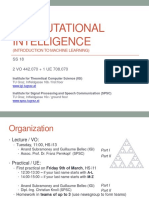0% found this document useful (0 votes)
51 views39 pagesFAI 1 Introduction
This document provides an overview of an artificial intelligence course. It introduces the instructor and teaching assistant. The course will cover fundamentals of artificial intelligence including supervised learning techniques like regression, classification, and neural networks. It will also apply these techniques to domains like computer vision, natural language processing through deep learning models. The schedule outlines topics to be covered over the semester.
Uploaded by
zhipengyang0110Copyright
© © All Rights Reserved
We take content rights seriously. If you suspect this is your content, claim it here.
Available Formats
Download as PDF, TXT or read online on Scribd
0% found this document useful (0 votes)
51 views39 pagesFAI 1 Introduction
This document provides an overview of an artificial intelligence course. It introduces the instructor and teaching assistant. The course will cover fundamentals of artificial intelligence including supervised learning techniques like regression, classification, and neural networks. It will also apply these techniques to domains like computer vision, natural language processing through deep learning models. The schedule outlines topics to be covered over the semester.
Uploaded by
zhipengyang0110Copyright
© © All Rights Reserved
We take content rights seriously. If you suspect this is your content, claim it here.
Available Formats
Download as PDF, TXT or read online on Scribd
/ 39























































































